|
¡¡
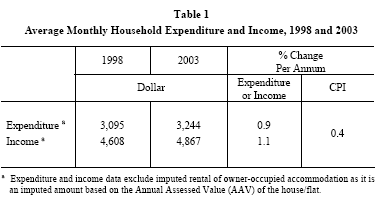
During the period 1998 ¨C 2003 when the economy
slowdown had impacted the labour market and household income from
work, the government had implemented several measures to help
Singaporeans, especially those in the lower income groups, to tide
over this period of difficulty and to adjust to the higher rates
of the Goods and Services Tax (GST). These measures have had a
positive impact on the financial situation of households. For
example, after taking into account the rebates and waivers on rent
and utilities for Housing Development Board (HDB) flats and
Economic Restructuring Shares (ERS), per capita income of
households in all the quintile income groups registered positive
rates of growth between 1998 and 2003. More significantly, the per
capita income of households in the lowest quintile income group
which registered a decline of 1.6 per cent per annum during the
same period, showed a gain of 0.1 per cent per annum after rebates
and ERS were taken into consideration.
Despite the slower growth in income and expenditure, all
households including those in the lower income groups had achieved
higher standards of living during 1993 ¨C 2003, as reflected in the
higher ownership rates of home and consumer durables.
Home ownership rate rose further from 91 per cent in 1998 to 92
per cent in 2003. The improvement in the home ownership rate for
households in the lowest quintile group was more significant,
increasing from 75 per cent to 80 per cent in 2003.
Ownership of most consumer durables had become more prevalent
among all households (Table D in Annex). In 2003, some 83 per cent
of the households had an audio/video compact disc player, much
higher than the 20 per cent registered in 1993. Almost nine in ten
households had a handphone in 2003, compared with less than one in
ten households in 1993. The proportion of households with personal
computers also surged from 20 per cent in 1993 to 70 per cent in
2003. The proportion of households with cable TV subscription
increased from 14 per cent in 1998 to 35 per cent in 2003 while
those with Internet access more than doubled from 23 per cent to
56 per cent during the same period.
Similar trend was observed for the low income group where consumer
durables such as audio/video compact disc player, air-conditioner,
as well as infocommunication products/services were more prevalent
in their households (Table E in Annex). Among households in the
lowest quintile group, some 61 per cent had an audio/video compact
disc player in 2003, compared with 5.4 per cent in 1993. While
only one in ten households had an air-conditioner in 1993, the
proportion increased to more than two-fifths in 2003. From less
than 1 per cent of households owning handphones in 1993, the
proportion rose to more than 60 per cent in 2003. The proportion
of households with personal computers was high at over 30 per cent
in 2003, up from 4.1 per cent in 1993. Almost 20 per cent of
households had Internet access in 2003 compared to 4.7 per cent in
1998.
Data Dissemination
DOS is releasing the results of the Household Expenditure Survey,
2002/03. The text of the report is available at the Department¡¯s
website at
http://www.singstat.gov.sg. The softcopy version of the full
report with more detailed tabulations can be purchased at SingStat
DataShop@GovMall with effect from 23 June 2005. The hardcopy of
the same publication will be available in late July 2005 at SNP
Corporation Ltd, 1 Kim Seng Promenade, #18-01 Great World City,
East Tower, Singapore 237994 (Tel: (65) 68269691 / Fax: (65)
68203341).
¡¡
SINGAPORE DEPARTMENT OF STATISTICS
June 2005
¡¡
- - - - - - - - - - - - - - - - - - - - - - - - - -
ANNEX
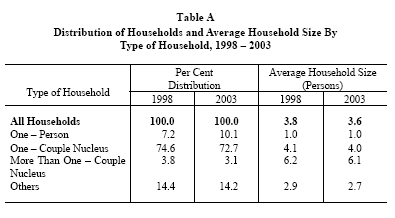
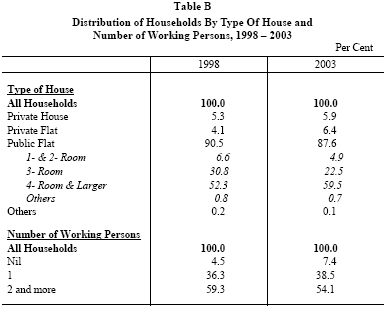
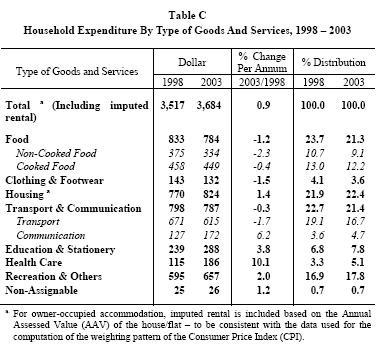
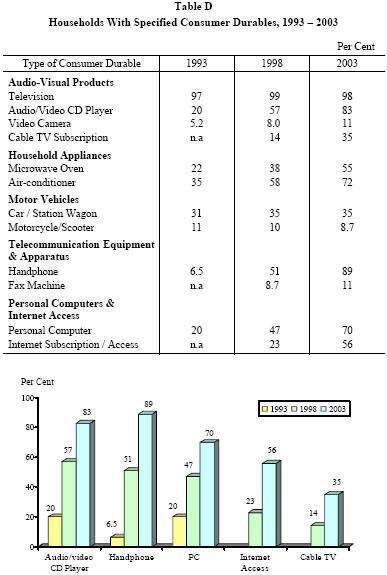
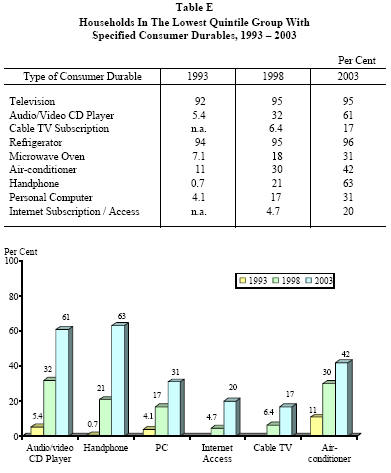
Source:
Singapore Department of Statistics
Press Statement 17 Jun 2005
¡¡
|